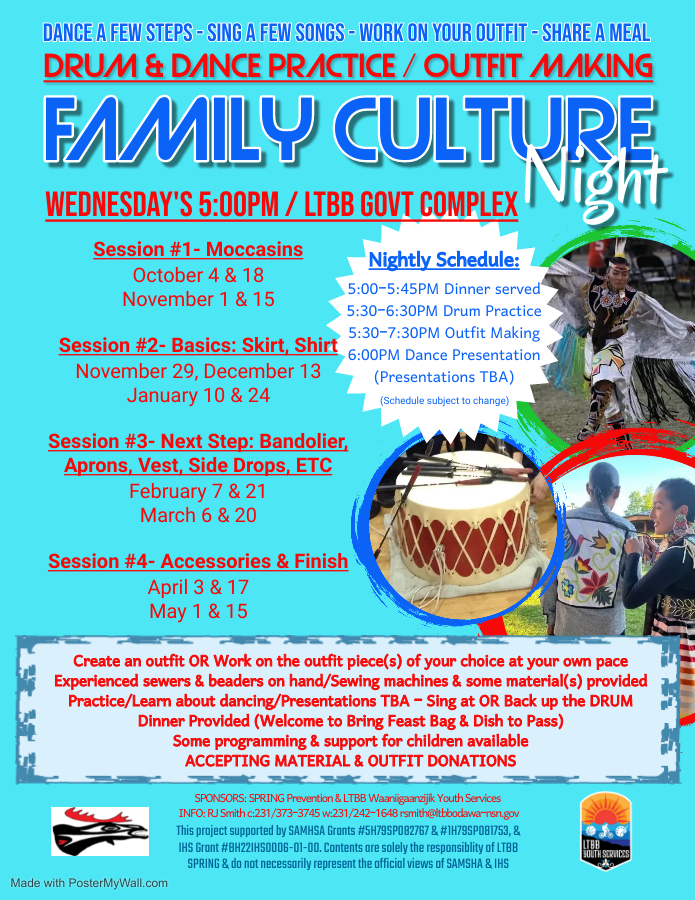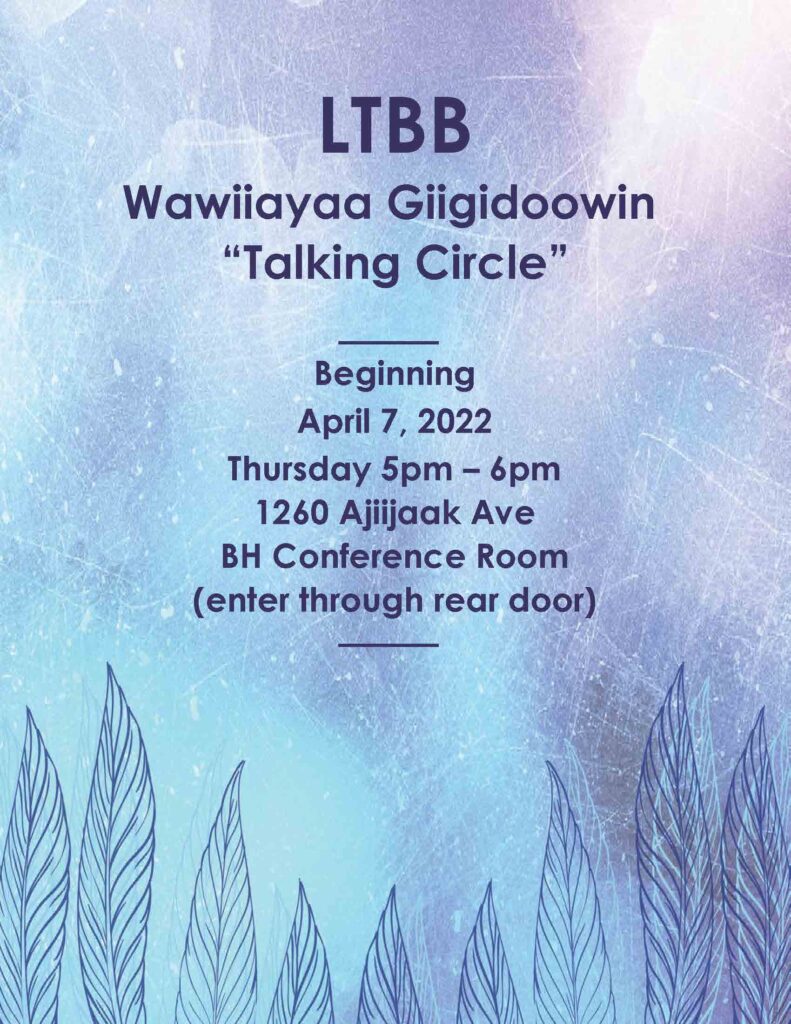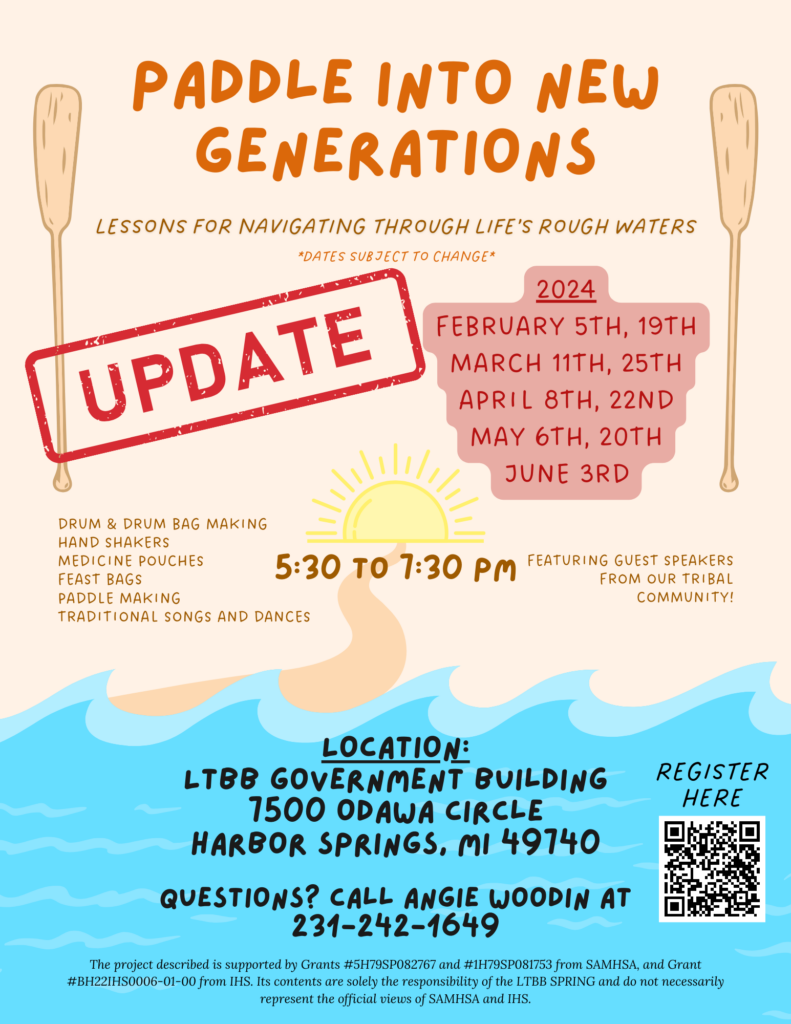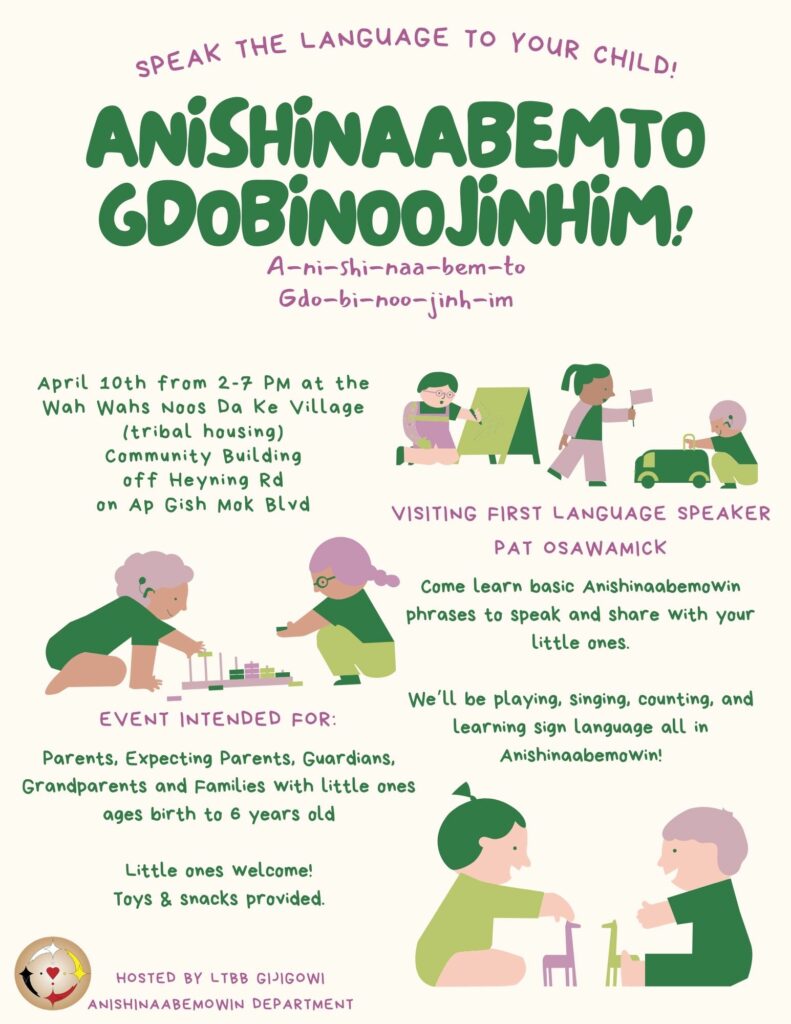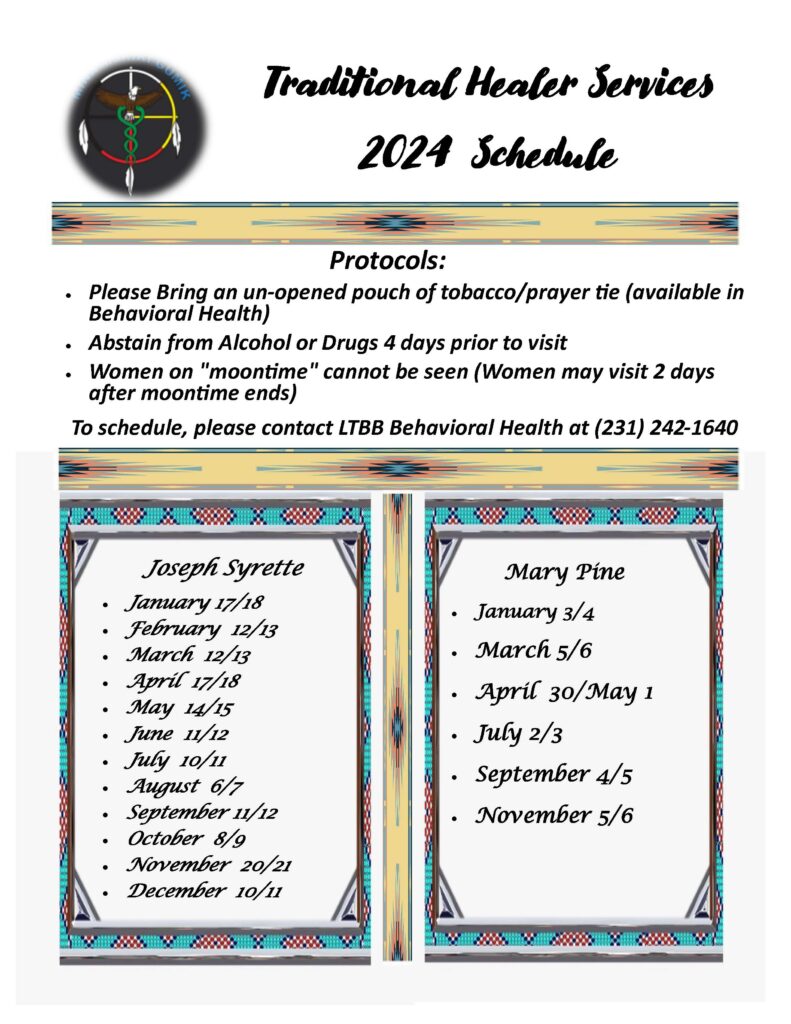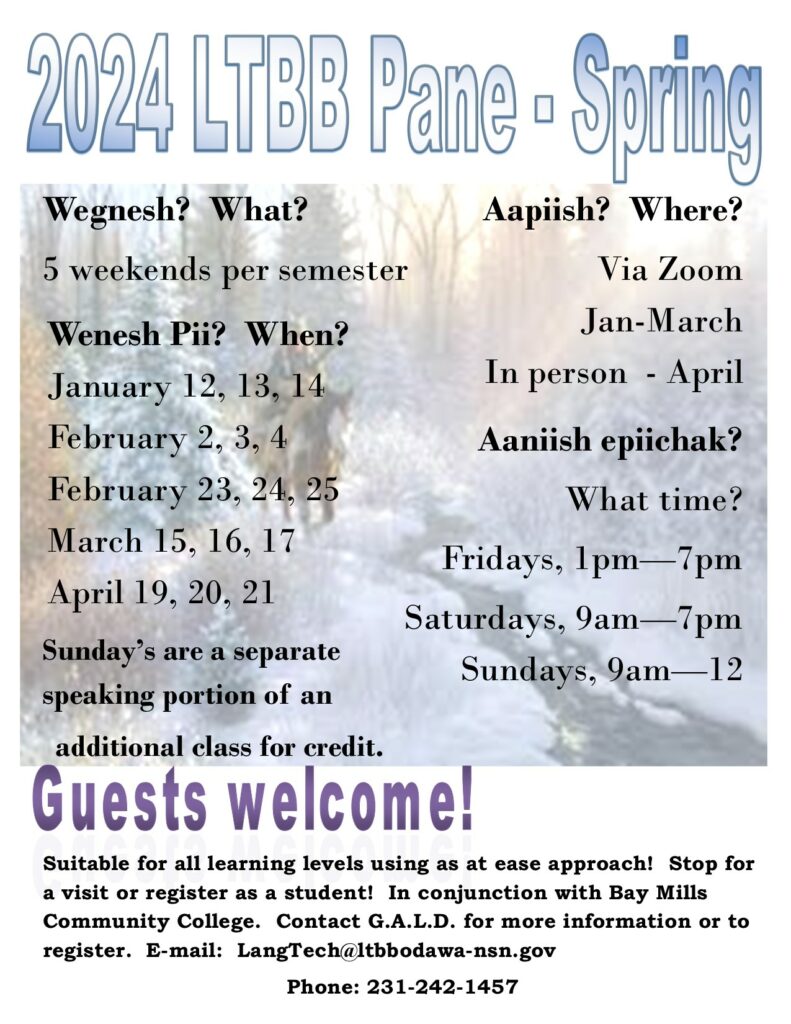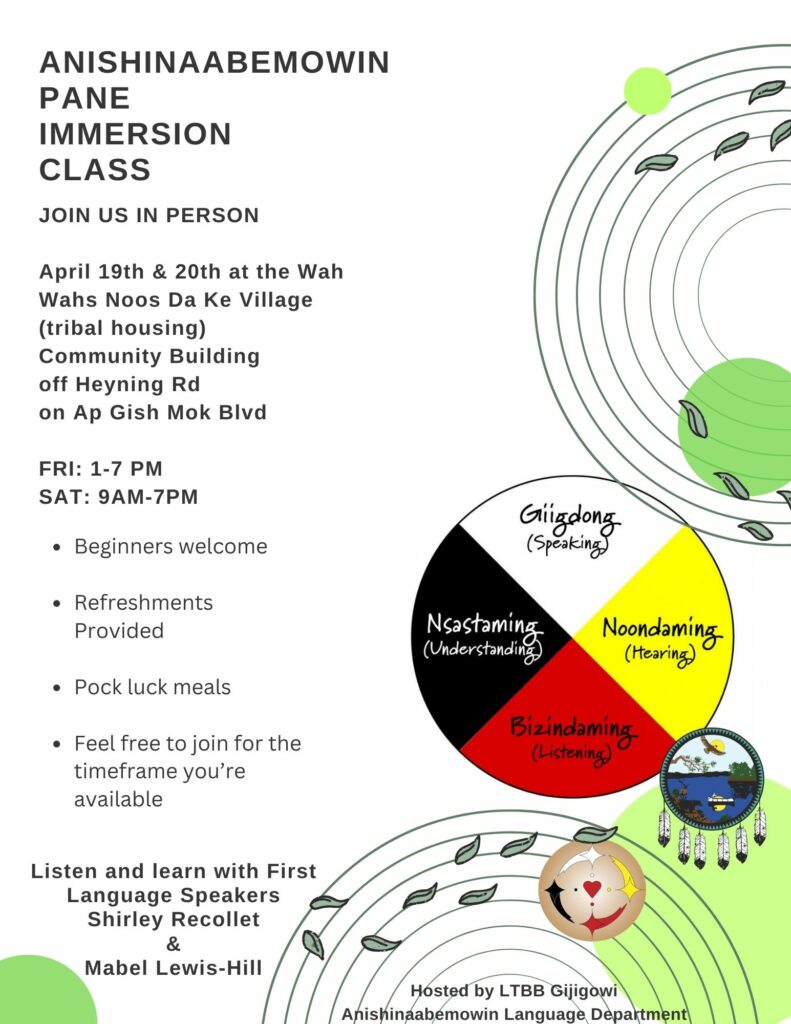Anishinabe Justice and Peacemaking Traditions
Compiled by LTBB Court Development Specialist Dave Keller
Wenona Singel (Reviving Odawa Traditional Justice in the Little Traverse Bay Bands Community: Some Preliminary Thoughts for Discussion)
- During an interview, one Little Traverse member commented that peacemaking should strengthen family life and respect the structure of the clan system.
- …the project of revitalizing peacemaking must serve multiple purposes. In addition to building effective dispute resolution, tribal members engage in healing the community and vesting the next generation with the knowledge and tools to secure their collective well-being.
- At the Little Traverse Social Services office, interviewees explained that credibility is linked to tradition, since “peacemaking is a practice since creation.”
- One individual linked peacemakers to oichidam[ogitchidag?], or the traditional Ojibwa police.
- …elders should be candidates for peacemakers.
- …peacemakers should be parents, and they should be sober. Life experience was at the core of peacemaking qualifications recognized by the group.
- Criteria that were offered to select peacemakers include having an open-minded nature, having a good ear, being a good person, having traditional knowledge, and having strong relationships in the community. Some emphasized that peacemakers do not need (college) degrees to be qualified.
- In some cases, over-formalization of the process may strip peacemaking of fundamental cultural approaches to dispute resolution that value flexibility and relativity.
- …juvenile justice may be an especially appropriate field for peacemaking’s initial application.
Andrew J Blackbird (History of the Ottawa and Chippewa Indians of Michigan)
- He was arrested and committed to the council and tried according to the Indian style; and after a long council, or trial, it was determined the murderer should be banished from the tribe.
J. Clifton, G. Cornell, J. McClurken (People of the Three Fires: The Ottawa, Potawatomi, and Ojibway of Michigan)
- In matters of importance, such as …threats to peaceful relations within the village itself, the village leaders assembled in council to decide on a course of action.
- The first rule in Ottawa society was respect for the individual. No one person could determine the fate of another. Each person was respected because of individual powers and achievements. Personal actions were the result of personal decisions, but proper behavior benefited all members of the village or family group.
- The second rule was that all members of the group must share their material wealth, labor, and food.
- The exchange of gifts was governed by a set of rules which bound giver and receiver. Each gift required some form of return and extended obligations of reciprocity across family lines to other tribes as well.
- Because each person was so important in producing food shelter, and clothing, the Ottawa system depended on cooperation, not competition.
- Families whose goals conflicted with those of their fellow Ottawa sometimes moved away and formed their own centers of operation.
- Individuals who violated the rules faced exile; in extreme cases, such as murder, those who broke the rules risked execution.
- The family was the most important social and political unit in Ottawa culture. Family relationships were defined by a complex set of rules which when extended to their farthest conceptual limits, linked all people in terms of kinship.
The Fund for Dispute Resolution (Anishinaabe Justice in Muskrat Dam—A Study of Past and Present Practices)
- The clan system governed every aspect of life…And it included policing and justice.
- “Do not condemn the person with a problem, but show them friendship and compassion. If we only look at the person and the problem with anger or hate, nothing will ever be accomplished.”
- Policing in the community is by traditional peacekeepers, not First Nations constables and the OPP.
- The contemporary [justice] practices are no less traditional than the practices of long ago, but they are also modern.
- “When something happened, we made every effort to find the root of the problem, what caused the turmoil to take place, and we would make every effort, based on what was found, how to help the people or person that was involved.”
- The Anishinaabe way is holistic with many community members involved approaching many aspects of an issue at once.
- Dysfunctional behavior was intervened in not so much because it was considered to be wrong, but more because it was seen as damaging to the person behaving in a dysfunctional manner and the community as a whole. And to an extent, the whole community…was involved in trying to keep people on the right road.
- Intervention was always in a caring manner…It was not intended to punish wrongdoers.
- It also had the effect of retaining in the community every person born into it.
- Chief and council did not act alone, the church leader or leaders were almost always present also.
- Christian doctrine and the Bible were very much a part of the teachings given to the person in trouble.
- Intervention was for the most part swift and public.
- “They didn’t try to cover up anything that happened. It was exposed and dealt with immediately. …confidentiality was not an issue.”
- Most of the issues were dealt with at the homes of the individuals that were involved.
- Where it was considered more serious a meeting might be held in the open perhaps with the whole community present.
- Gifts were sometimes given to reinforce the teachings offered by the leaders.
- “And the couple usually answered yes, they will not act ill towards each other and they will forgive each other. It was at that time that gifts were given to each other.”
- “After the issue had been resolved to everyone’s satisfaction, nobody would refer to it again outside that place.”
- In addition to the chief and the spiritual leaders keeping a watchful eye over the community, there were also “designated persons” or peacekeepers…describe(d) variously as oganawengike, the keeper; odabaajimoog, the reporters; and, onagachecheka, the person who watches.
- She describes them collectively as omaminomowayak, the people who set things right.
- Chiefs, spiritual leaders and peacekeepers traveled around their territories making sure that things were as they should be.
- The omaminomowayakdid not work alone. They worked in groups and most of the time the whole community was involved in setting things right.
- With serious matters, and where community harmony was severely threatened, a circle process was used.
- Finally, with the most serious cases, and where the community was uncertain how to deal with a particular matter, the chief might call in the white justice system either to act as support to the Anishinaabe system or to take a particularly intransigent person out of the community.
Melissa Pflug (Ritual and Myth in Odawa Revitalization)
- Ritual cooperation, as mythically mapped, sets the precedent for such traditional social structures as councils, which as political institutions seek consensus and as social institutions seek collective unity and identity.
- First, cooperative interactions create social relationships and identity. Second, there are constructive ways to address others whose actions are socially disruptive. And third, social identity and power derive from consensus.
- …through his own personal transformation Nanabozho illustrates not only that persons do not always behave with constructive purposes but also that powerful personal and social metamorphosis is possible if each person acts to contribute to pimadaziwin—the good, healthy, and moral collective life.
- Their actions affirm Nanabozho’s lessons that power is amplified in communal discussions, and that persons and groups can work collectively to transform their status.
- …it abandoned the tradition of political decentralization and undermined the authority of individual band councils, the power of which was originally established by Nanabozho.
- …Nanabozho is a model for ethical behavior and mediation of interpersonal conflict.
- And they stress that proper “thinking” is accomplished with one’s heart instead of one’s brain.
- “We see law as a matter of reestablishing equal and just relationships—not a matter of authority, per se.”
- Generally, Odawa traditionalists do not approach justice as punitive or retributive…Instead, justice is viewed as regenerative and a matter of personal and social healing.
- For traditionalists…mediating disagreements through gift exchange unites people…
- As he understands it, they have committed a behavioral breach that has hurt both themselves and there communities. Enacting justice becomes a ritual that re-establishes right and equalized relationships.
- “I’m just there to help guide [Indian inmates’] transformation and help them heal themselves.”
- These Odawa approach the mediation of disagreements and disruption caused by personal malfeasance and social transgressions not as a matter of legal adversarial adjudication but as just and consensual negotiation.
- Odawa traditionalists approach the world through the principle of “Equal Law under Justice,” not the opposite…
James M. McClurken (Gah-Baeh-Jhagwah-Buk—The Way It Happened)
- Most often, Ogemukwere male, though on occasion, women also served as leaders.
- As long as an Ogemawas respected by his people, he was sought to provide guidance in village and personal matters.
- The Ogemuknegotiated settlements to disputes and held councils in which all villagers spoke their opinions. Important councils…could take days of oratory and skilled listening to win a consensus of followers.
Rupert Ross (Returning to the Teachings—Exploring Aboriginal Justice)
- “…The Indian communities view a wrongdoing as a misbehavior which requires teaching or an illness which requires healing.”
- …almost every aspect of our Western approach to justice breaks traditional Aboriginal law.
- I have found, however, that my skepticism just couldn’t survive the eyes and voices of so many old people, men and women alike, speaking only their own ancient languages, all looking dumbfounded (or outraged!) at my suggestion that punishment might be used to make things better. Nor could it withstand sitting in the sexual abuse healing circles at Hollow Water,…where the ancient teachings of the medicine wheel come to life to move victims and offenders forward out of their hurt and anger.
- I have never heard an Aboriginal community say that healing can work with everyone…
- They wanted to restore the situation where no one received such power over others, where such decisions came out of the clans and families from the bottom up, not the top down.
- The law of fierce competition, however, does not appear to be the law that many Aboriginal peoples draw from their study of the non-human world. Instead, they have drawn an opposite conclusion: that Creation demonstrates, at its most fundamental levels, principles of mutualism, interdependence and symbiosis…According to that perspective, the obligation of humans is not to attack, insult or diminish them or each other, but to demonstrate respect, to offer support, to work towards cooperation.
- The problem in many Aboriginal communities, I now suspect, lies not in noninterference but in the fact that this approach is no longer accompanied by teaching about responsibilities or by any guidance in developing essential personal capacities.
- …I wrote about decision-making techniques whereby people are not asked to state their recommendations, then fight for them—because in such processes, there will inevitably be those who come away feeling like winners, while others may feel either left out or put down. To traditional eyes, few decisions are worth such kinds of unhealthy developments in the relationships between people. Instead. Everyone is given an equal, often formal, chance to participate…If no substantial common approach appears to be emerging, the decision may well be put off to another day… It is the process that must be the winner…
- …since acts are not as important as the relationships that spawn them, trials about acts no longer occupy center stage. This change in focus may even mean that, if the parties have been guided through an effective peacemaking process, it may be totally unnecessary to come to a conclusion about who did exactly what to whom!
- Traditional teachings seem to carry a suggestion that people will always have different perceptions of what has taken place between them. The issue, then, is not so much the search for truth but the search for—and the honoring of—the different perspectives we all maintain.
- I wrote about an Ojibway woman who made a presentation at a workshop on sexual abuse. She explained that she would tell her own story of abuse in Ojibway, rather than English, because it was a softer language, one that tried to stay away from labels like “the accused” and the offender.” Those kinds of words, she said, had a tendency to stigmatize people, to “freeze” them within a particular classification, making it more difficult for healing to occur.
- It is an Ojibway teaching, for instance, that healthy relationships—and “a good life”—depend on constantly cultivating seven attributes: Respect, Caring, Sharing, Kindness, Honesty, Strength and Humility. In both the group and individual sessions [at Hollow Water], the team examines all the relationships people have been maintaining with each other, with themselves and with all of Creation. In doing so, they look at how much, or how little, those attributes are present. It is understood that everyone is capable of improvement in all of them, at all times, throughout their lives.
- I therefore offer this caution: unhealed people cannot bring healing to others—only an escalation of their illnesses—and the creation of a healthy team at Hollow Water took several years of great personal dedication, a lot of pain and a sustained relearning of the traditional teachings.
- Looking for traditional teachings, I should point out, does not mean an insistence on reviving every traditional process as well. Adjustment of those processes is clearly called for, given changed realities. As the writers of the final report of the Dene Justice Project in the Northwest Territories stated in 1993: “Many of the practices from the past cannot address current problems. However, if the values attached to those practices could be reclaimed, and new practices built on them, then it could work.”
Christie Jefferson (Conquest by Law)
- The Ojibway tribes maintained peaceful co-existence among their members through exemplary behaviour of their leaders, established tradition taught by the elders, religious or supernatural powers, and public disgrace of a violator.
- Personal disgrace, and its reflection on the shamed person’s family, were effective tools in the hands of the chiefs and councils in controlling unruly and offensive behaviour.
- The chief was expected to intervene in disputes between band members, and be actively involved in the negotiations with other band and tribe chiefs. Strife within a family, however, was left to the head man to handle…
- In the more easterly villages, the chief and council formally deliberated on serious theft and in murder. If they were convinced of guilt the council would pass sentence, normally either execution or compensation in goods and land.
Rev. Stewart Folster (Ojibway Rituals and Symbols)
- In conflict resolution, Ojibway culture and spirituality encourage us to use a gentle and honest approach that shows respect for everyone involved.
- So sacrifices have to be made from those in conflict, and they must learn to exemplify an attitude and life of caring and sharing.
- …conflict resolution can be done as a community. I have seen much healing take place in sharing circles. It is important to have an elder present to begin the whole process with prayer and ceremony and a teaching from the medicine wheel.
- …the elder might suggest that they hold an eagle feather to represent truth, honesty, sharing and caring.



